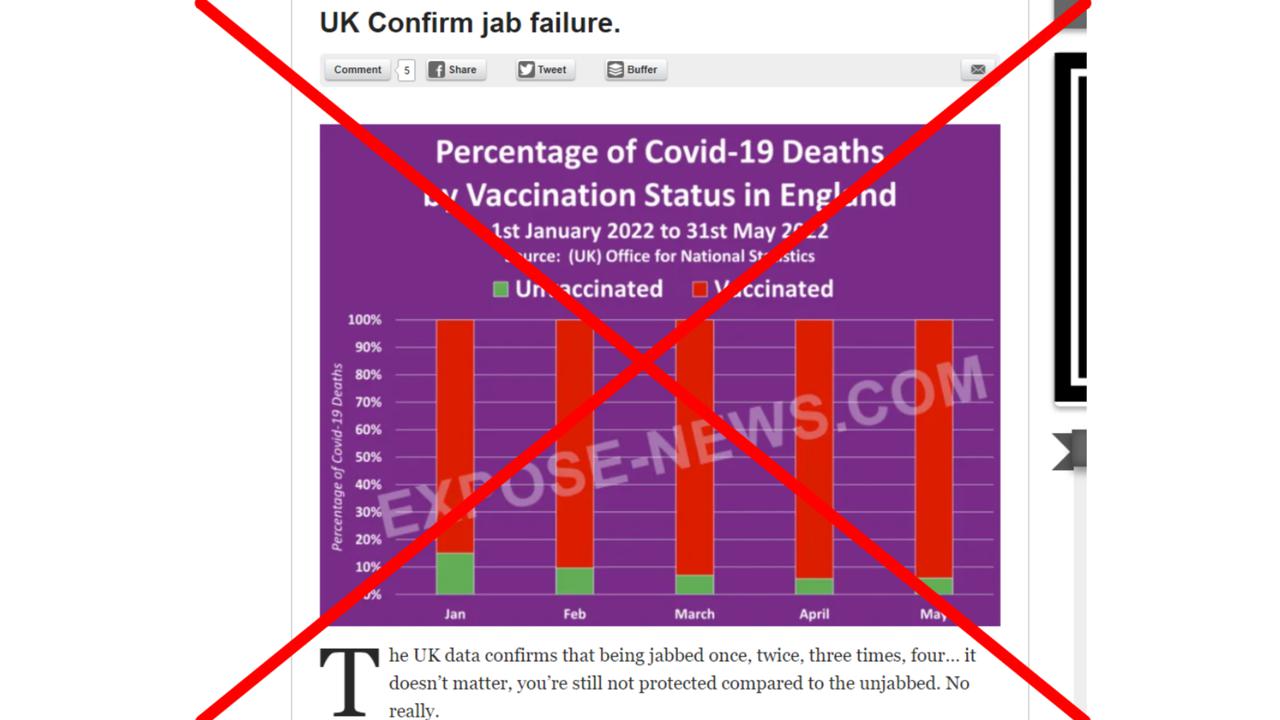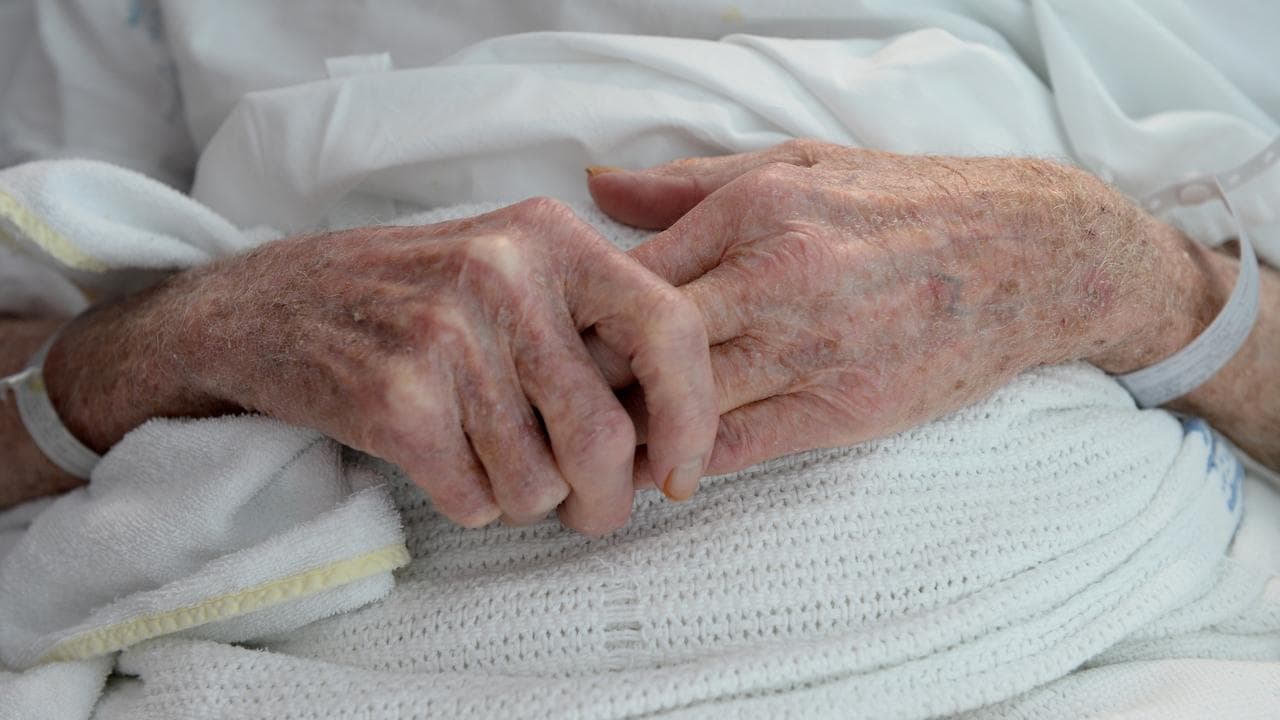WHAT WAS CLAIMED
UK data shows vaccinated people are no better protected from COVID-19 death than the unvaccinated.
OUR VERDICT
False. Age-adjusted UK figures show vaccinated people are far less likely to have died with COVID-19.
An Australian blogger says data from the UK's Office of National Statistics (ONS) reveals vaccinated people are no better protected from COVID-19 death than the unvaccinated.
The claim is false. It is based on a faulty comparison between vaccinated and unvaccinated COVID-19 deaths in England across all age groups.
It fails to take into account age differences between the two groups. Age-adjusted figures published by the ONS show COVID-19 mortality rates for unvaccinated people are far higher than for vaccinated people.
The claim was made in a July 26 blog post from Topher Field, who describes himself as a "a leading advocate for less government and more freedom".
The blog post said: "The UK data confirms that being jabbed once, twice, three times, four… it doesn't matter, you're still not protected compared to the unjabbed."
"In other words there is no statistically significant protection being offered by the jab," Mr Field wrote. The claim is also made on his Facebook page.
Vaccination rates are published on the UK government's COVID-19 data hub here. Statistics about deaths by vaccination status in England are published by the ONS here.
Mr Field described the death statistics as "UK data", though health is a devolved issue in the UK and the data only covers deaths registered in England.
Experts told AAP FactCheck that Mr Field's analysis of the data was nonsense, overly simplistic and failed to account for the different age structures of vaccinated people when compared to unvaccinated people.
"Vaccination rates have consistently been higher in older people and so any comparison between vaccinated and unvaccinated groups will inevitably be comparing two groups with very different age profiles and therefore be almost meaningless and certainly of no value for establishing the effectiveness of vaccination," Colin Angus, a senior research fellow at Sheffield University's School of Health and Related Research, told AAP FactCheck in an email.
The vast majority of England's COVID-related deaths during the first half of 2022 were people aged 65 years or older.
Dr Angus said a fairer way to compare the data was to use age-standardised mortality rates (ASMRs), which adjust for differences in the age structure of the groups being compared.
"A comparison of age-standardised mortality rates by vaccination status, using the same ONS data, shows that mortality rates from COVID-19 in unvaccinated people are substantially higher than in the fully vaccinated," he said.
ASMRs were published in the same dataset that was used to make the claim, but were not mentioned in Mr Field's article.
The ASMR of unvaccinated people in England in January 2022 was 509.8 deaths per 100,000 people, according to figures in the ONS dataset (table 1, row 266).
By comparison, the ASMR for people who were "ever vaccinated" was about 4.6 times lower at 109.8 deaths per 100,000 people (table 1, row 274).
In May 2022, the equivalent ASMRs were 77.6 unvaccinated COVID-related deaths per 100,000 people (table 1, row 302) and 35.5 vaccinated COVID-related deaths per 100,000 people (table 1, row 310), meaning unvaccinated people were still about twice as likely to have died with COVID-19 when compared to vaccinated people.
Dr Angus said the narrowing gap in age-standardised COVID-19 mortality rates between vaccinated and unvaccinated people was in part due to the high infectiousness of the Omicron variants.
"The vast majority of vaccinated and unvaccinated people will now have been infected at least once, so comparing the two groups is now more like a comparison of combined vaccine plus natural immunity versus natural immunity alone," he said.

Professor David Spiegelhalter, chairman of the Winton Centre for Risk and Evidence Communication at the University of Cambridge, also told AAP FactCheck Mr Field's claim was based on a faulty interpretation of the ONS figures.
"This is complete nonsense, and any sensible analysis of the data disproves it," Prof Spiegelhalter said in an email.
"The risks of COVID depend so strongly on age that it is essential to compare those of similar age.
"The majority of COVID deaths happen to older, more vulnerable people because they are older and more vulnerable, and although the vaccine is very good at protecting against severe outcomes, it is not perfect. Just like most car fatalities are wearing seat-belts, they reduce the risk, but don't eliminate it."
ONS head of mortality data Sarah Caul took to Twitter on July 14 to tackle misleading claims vaccinated people were more likely to die with COVID-19.
"The number and characteristics of those who are vaccinated and unvaccinated are different ... we need to take these into account when looking at the number of deaths for each group," Ms Caul tweeted.
"Using age-standardised mortality rates, which takes into account the size and age structure of the groups (t)hose vaccinated had a significantly lower rate of death involving COVID-19 for both males and females in April and May."
The ONS has said the risk of death involving COVID-19 in England has been consistently lower for people who had a third vaccine dose or booster when compared with unvaccinated people.
AAP FactCheck has debunked similar claims vaccinated people in England had a higher risk of dying from COVID-19.
Other claims that vaccinated people were equally or more likely to die with COVID-19 have been fact-checked here, here and here.
The Verdict
The claim vaccinated people in the UK are no more protected from COVID-19 death than unvaccinated people is false. It is based on an overly simplistic and misleading interpretation of official data.
Experts told AAP FactCheck any comparison of the data must take into account structural age differences between vaccinated and unvaccinated groups of people. Age-adjusted figures from the UK's Office of National Statistics show vaccinated people were far less likely to have died with COVID-19 when compared to unvaccinated people.
False - The claim is inaccurate.
AAP FactCheck is an accredited member of the International Fact-Checking Network. To keep up with our latest fact checks, follow us on Facebook, Twitter and Instagram.












